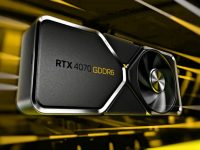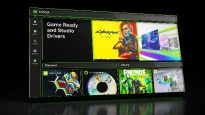AMD Radeon RX 460 video card testing. Budget VGA become faster
22.08.16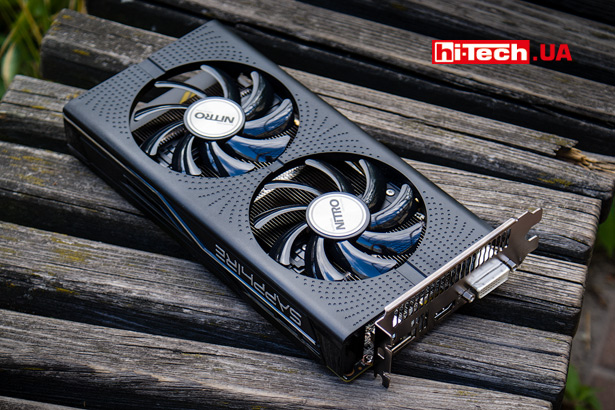
2016 turned out to be very rich in new products from both NVIDIA and AMD. If NVIDIA has focused its attention on high- and mid-range performance video cards (TITAN X, GTX 1080, GTX 1070, GTX 1060), then the new AMD video accelerators can be classified as average and entry-level (Radeon RX 480, RX 470, RX 460).
The AMD Radeon RX 460 discussed in this material is the youngest video card of the trio of AMD’s latest generation video adapters Radeon RX 480, RX 470 and RX 460.
All these devices are based on the new Polaris architecture (Graphics Core Next fourth generation) and have GPUs made on a 14-nanometer process technology.
Compared to previous generation solutions, this has significantly improved performance per watt of energy consumed.
If we compare the characteristics of the AMD Radeon RX 480/470/460 (see table), we can see that the AMD Radeon RX 480 and RX 470 differ from each other not so much, but the RX 460 is noticeably weaker than its counterparts.
Unlike the RX 480 and RX 470, which use the Polaris 10 GPU, the AMD Radeon RX 460 is based on a more compact Polaris 11 GPU (almost half the die area) with fewer transistors. Accordingly, the number of computational units and stream processors turned out to be noticeably smaller.
The AMD Radeon RX 460 video card can be classified as an entry-level device. The recommended price for this model with 4 GB of memory is $119. The manufacturer positions it as a good solution for not too demanding games, as well as e-sports games, for example, Counter-Strike, Dota 2, World of Warships, Overwatch.
What features would you like to note in AMD Radeon RX series video cards?
The boards support the latest DisplayPort interfaces (1.3 HBR3, 1.4-HDR, HDMI 2.0b), necessary for connecting advanced 4K and higher panels with high screen refresh rates. Many complaints about AMD’s previous generation video cards were due to the fact that they do not support the fairly current HDMI 2.0. At the same time, NVIDIA video cards have been working with HDMI 2.0 for a long time.
The hardware capabilities for video encoding and decoding have been significantly updated. HEVC (H.265) encoding and various advanced formats are supported, combining high resolution (up to 4K) with high frame rates per second.
The usual section in the proprietary AMD Overdrive control panel, related to video card overclocking, has been replaced with the more advanced Radeon WattMan. The new tool allows you to more finely tune frequencies, adjust fan operation, change voltages, etc. For enthusiasts, the field for experimentation is now much wider.

The new Radeon WattMan utility provides the user with more options related to configuring the operation of the video card, overclocking it and monitoring its condition
The new architecture of AMD Radeon RX graphics cards is well suited to work with the DirectX 12 API, which provides more direct access to the GPU hardware capabilities. AMD has also prepared its proprietary Vulkan API. In games with its support, you can expect a certain increase in the performance of AMD video cards.
SAPPHIRE NITRO RadeonRX 460 4 GB
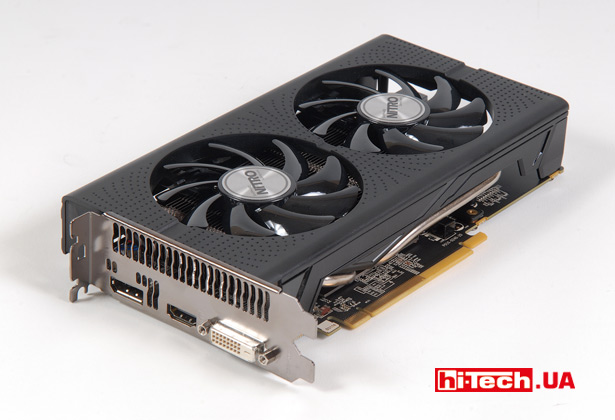
SAPPHIRE NITRO Radeon RX 460 4 GB
The AMD Radeon RX 460 in our test was played by the SAPPHIRE NITRO Radeon RX 460 4 GB video card. Compared to the reference model, this model has slightly increased GPU frequencies – from 1090–1200 to 1175–1250 MHz. The standard memory frequency is 7000 MHz (resulting memory frequency).

Much attention has been paid to fans. Their design uses double bearings. The proprietary Quick Connect system is also claimed to be used, allowing the user to very easily remove the fan for cleaning or replacement.

The SAPPHIRE NITRO Radeon RX 460 graphics card is small, but the AMD Radeon RX 460 reference variant is even smaller
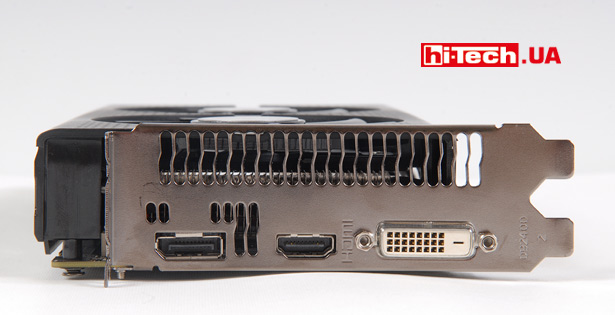
Some modern AMD video cards no longer have DVI video output, but the RX 460 does. For this class of video cards, this connector remains very relevant.

The cooling system of SAPPHIRE NITRO Radeon RX 460 4 GB is quite advanced. A solution with heat pipes and a pair of large fans is used. As a result, the video card turned out to be very quiet. The maximum temperature we recorded in the most severe operating conditions was 75 °C, and in most cases the temperature did not exceed 66 °C, which is not bad.
Like many modern video cards, the SAPPHIRE NITRO Radeon RX 460 can completely stop the fans at low loads, which ensures silent operation of the device. Shutting down occurs when the GPU temperature drops below 45 °C, and the fans turn on when the GPU temperature is 52 °C or higher.
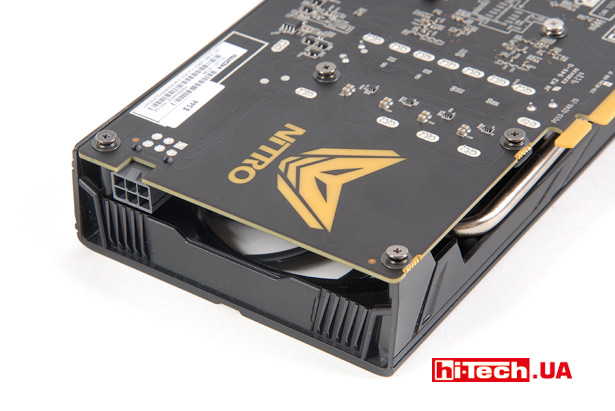
On the back of the board you can see the NITRO logo. When the video card is running, this logo is illuminated by several LEDs.
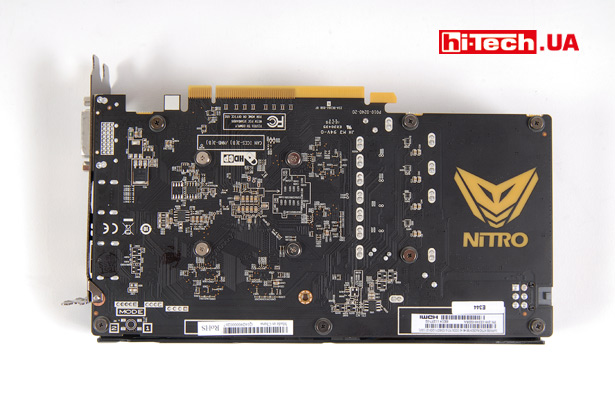
As you can see, half of the contacts are missing on the site. The video card (not only this SAPPHIRE NITRO Radeon RX 460 4 GB, but also other RX 460) supports not PCI Express 3.0 x16, but PCI Express 3.0 x8. But don’t worry: even the interface bandwidth cut in half is sufficient for this video card with a large margin
Performance and power consumption
While NVIDIA has not introduced the latest generation of entry-level video cards, the closest competitors from NVIDIA for the AMD Radeon RX 460 are the previous generation models GTX 750 Ti and GTX 950.
We haven’t tested a representative of the NVIDIA Geforce GTX 750 Ti for quite some time, so for comparison we chose a video card based on the NVIDIA Geforce GTX 950 (ASUS GTX950-2GD5).
The GTX 950 is more expensive than the RX 460, and it will be interesting to see how much, if any, AMD’s new product lags behind its rival.
Test platform configuration:
- Processor: Intel Core i7-3770K, overclocked to 4.2 MHz
- Motherboard: Biostar Hi-Fi Z77X
- RAM capacity: 4×2 GB DDR3 1600
- Drives: SSD Adata S511 120 GB (system), HDD 1 TB
- Operating system: Windows 10 64 bit
- Drivers for video cards based on AMD Radeon RX 460: AMD Crimson 16.8.1
- Drivers for video cards based on NVIDIA Geforce GTX 950: GeForce 365.10
Test histograms:
According to the test results, the AMD Radeon RX 460 performed by the SAPPHIRE NITRO Radeon RX 460 4 GB, in general, was indeed inferior to the NVIDIA Geforce GTX 950, but in some tests it even managed to outperform its competitor.
Note that the tests and benchmarks we used worked maximum under the DirectX 11 API. And in games with support for DirectX 12 and the Vulkan API, of which there are not so many now, but every month there are more and more of them, AMD video cards are attractive in terms of performance Radeon RX 460 may grow slightly.
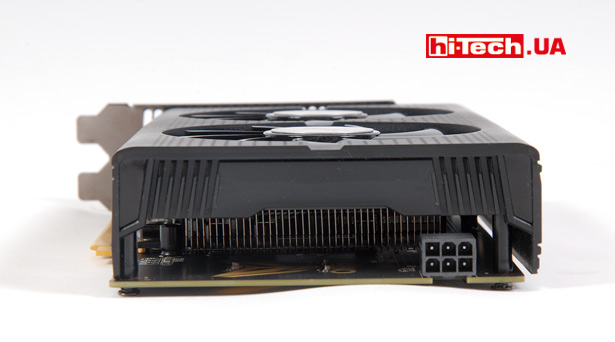
Regular RX 460 are so economical that they do without an additional power connector. But the presented SAPPHIRE NITRO Radeon RX 460 still requires a six-pin power plug. This was done, among other things, for some margin during overclocking.
The measured power consumption of the system with SAPPHIRE NITRO Radeon RX 460 in loaded mode was 185 W. With the various GTX 950 graphics cards we had on test, the same system’s power consumption ranges from 165-197 Watts.
2 GB or 4 GB?
The AMD Radeon RX 460 graphics card is available in versions with 2 and 4 GB of video memory. Is it worth paying a little more for the 4 GB option?
We only had the RX 460 version with 4 GB of video memory in our test, so we did not make a direct comparison.
But we can share some thoughts on this matter. The headroom you get with the 4 GB version, of course, won’t hurt, but the 2 GB option also looks quite appropriate in this class of video cards.
In demanding modes and games, when 2 GB of video memory is no longer enough, most likely the graphics processor itself simply will not be able to provide a comfortable level of FPS, so there will not be a big difference between 2 and 4 GB.
Conclusions
AMD has made a very good entry-level video card.
It is very economical and has good performance considering the price. There are also no complaints about functionality. The most modern connection interfaces are supported, the board has a good arsenal of hardware capabilities for working with 4K and Full HD video in various formats.
Due to architectural features, in new games with support for DirectX 12 and the proprietary Vulkan API, the potential of this board can be revealed a little more.
The recommended price of $119 for an AMD Radeon RX 460 with 4 GB of video memory looks very tempting, but there is reason to believe that such video cards will be offered significantly more expensive in our market at first.
The AMD Radeon RX 460 should cost less than the GTX 950. In this case, it will be a very attractive purchase.
As for the presented SAPPHIRE NITRO Radeon RX 460, this is a very worthy version of the RX 460 with slightly increased frequencies and an enhanced, interesting cooling system.
Characteristics of SAPPHIRE NITRO Radeon RX 460 4 GB
- Interface: PCI Express 3.0 x8
- GPU: Polaris 11
- Process technology: 14 nm
- Video memory: 4 GB, GDDR5
- Memory bus: 128 bit
- GPU frequency: 1175/1250 (boost) MHz
- Resulting memory frequency: 7000 MHz
- DirectX instructions support: 12
- Outputs: HDMI, DVI, DisplayPort
- Additional power connector: 6 Pin
- Supplier: AMD Representative
- Recommended price of AMD Radeon RX 460 2 GB: $99
- Recommended price of AMD Radeon RX 460 4 GB: $119
Rating:
+ good performance considering the price
+ excellent functionality
+ interesting cooling system
- larger compared to the reference one
Engineer of the Test Laboratory
Don't miss interesting news
Subscribe to our channels and read announcements of high-tech news, tes
Oppo A6 Pro smartphone review: ambitious

Creating new mid-range smartphones is no easy task. Manufacturers have to balance performance, camera capabilities, displays, and the overall cost impact of each component. How the new Oppo A6 Pro balances these factors is discussed in our review.
Editor’s Choice 2025. Best devices of the year by hi-tech.ua

The best gaming laptops, mice for work, gaming keyboards, smartphones, and wireless headphones of 2025. Among them, we will highlight the most interesting ones and those that we can recommend buying.
Modern Mercedes-Benz Unimog get 7.7-liter V6 car Mercedes-Benz
The concept is based on the Mercedes-Benz Unimog U 4023 with portal axles, a robust frame and a full set of differential locks. The main technical change was the replacement of the standard 5.1-liter diesel engine
Honor почне випускати ігрові смартфони games Honor smartphone
За швидкодію відповідають флагманські платформи Qualcomm: Honor Win побудований на Snapdragon 8 Elite, а Honor Win Pro – на новітньому Snapdragon 8 Elite Gen 5












